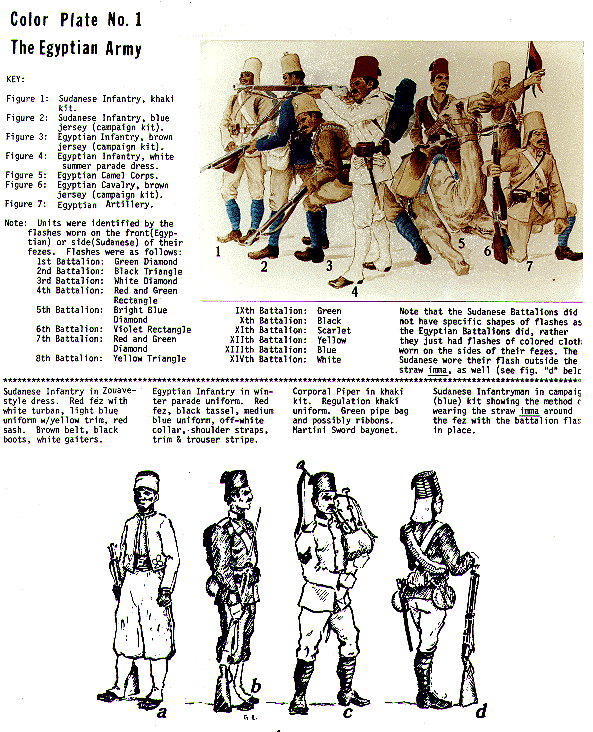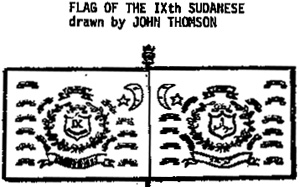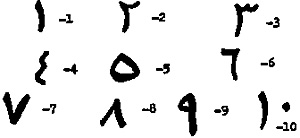 The army retained its white uniform of the earlier period up through 1885. Sometime in 1885 the new Khaki uniform was introduced. The cavalry and camel corps at Suakin were still in white by the end of the campaign (Haggard), but the Desert Column met Egyptians in khaki and puttees when they returned to Egypt in June and July (see Gleichen, Camel Corps).
The army retained its white uniform of the earlier period up through 1885. Sometime in 1885 the new Khaki uniform was introduced. The cavalry and camel corps at Suakin were still in white by the end of the campaign (Haggard), but the Desert Column met Egyptians in khaki and puttees when they returned to Egypt in June and July (see Gleichen, Camel Corps).
While the Egyptian battalions had khaki drill early the Sudanese were less uniform. The IXth did not get full khaki drill until 1887, and did not even have a full issue of boots before 1886 (Mitford, p. 181). At first they wore a dark blue jersey and puttees, fez, and white pants. They had no regulation equipment, each man being Issued a bit of leather out of which he improvised his own bandolier, same of very ornate design (Mitford, p. 175). When they finally did get their khaki drill and regulation equipment, they retained the blue jersey, and most men also kept their own bandoliers in preference to the new ammunition pouches which were stiff and often did not close properly (Mitford, p. 181). The XIth Sudanese began as a Gendarmerie battalion, and as such wore a zouave style uniform of dark blue cloth, red cumberbund, white spats and yellow piping (Mitford, p. 177).
They retained this uniform for some time after they were incorporated into the regular army, though one photo of the battalion at Suakin in 1891 shows them in the regular khaki drill (Scrapbook, Gordon Highlanders). This same zouave uniform was issued to all Sudanese battalions as a winter uniform in 1890, though the other battalions wore light blue piping. At this time the uniform was dark blue cloth, though a later photograph (1898) shows a uniform that Is either medium or light blue (Khalifa's House, Omdurman).
The color of the khaki drill used by the Egyptian army has been described as yellow and brown, the brown referring to the jersey the Egyptians wore. Churchill describes it as darker and not as yellow as British khaki (Churchill II, p. 427). All branches wore the jersey for marching order: the Egyptians wore brown and the Sudanese (including the Sudanese companies of the Camel Corps) wore dark blue.
Chevrons were red and were worn on the right arm of either the jersey or the khaki jacket. Officers, both native and British, never wore jerseys. One photo of an Egyptian officer shows him in a coat considerably darker than his trousers. Officers generally wore gaiters, though some wore puttees. British officers occasionally wore the fez, but this was mainly for ceremonial occasions. Most of the time they wore the Egyptian pattern sun helmet, which had a wider brim than the India pattern then in use by British regiments.
The fez (sometimes called tarboosh) was tall, though shorter fezes of earlier times seem to have been wore through the 80's and into the early 90's. It was sometimes worn plain, but there were four styles of immas (turbans) worn around it. The plain khaki immas with neckcloth was worn most often by all troops. It covered the top, and sometimes the neckcloth was tucked up under the fez leaving the back of the neck bare. So sketches in Churchill, however, show Egyptian cavalry with the neckcloth worn in front, part of it tucked under the fez to stiffen it like a hat brim to shade the eyes. The Sudanese battalions also had a plaited straw imma, stitched in back, with neckcloth, but leaving the top of the fez bare and tassel free. A plain white cloth was also sometimes worn by all leaving the top of the fez bare. Another variation of this was a bulky white cloth wrapped around the entire fez, covering the top as well. Regimental flashes and stripes were worn on the khaki and straw immas only.
Bandsmen wore the same uniform as the regular soldier. However, at times Sudanese wore their red sash over their blue jerseys. Each battalion had a drum and bugle band, while the brigades had full brass band. About 1886 the first bagpipe band was raised for the IXth Sudanese by a pipe-major from the Cameron Highlanders. By the end of the century almost all infantry battalions, Egyptian and Sudanese, had pipe bands. Bag covers and drums were dark green. The drums were trimmed in red along the top and bottom, had white tension ropes, and bore the regimental number and battle honors.
FLAGS
Each infantry battalion was issued a plain green silk flag, about 40"x32", with white Arabic (Hindu) numerals of the battalion on the center. These flags were carried into battle.
 The one battalion at this time that did have a distinctive regimental color was the IXth Sudanese.
The one battalion at this time that did have a distinctive regimental color was the IXth Sudanese.
This was presented to the battalion by the Cameron Highlanders on May 27, 1886, and returned to the Camerons when the IXth was disbanded in 1930. When first presented it had only Kosheh and Ginnis as honors, others being added later. It was of red (maroon) silk. The fringe was red and gold, the scrolls were buff edged in gold with black lettering, the central wreath was gold with green leaves, and the staff had a gold crown and crescent star on top.
In addition to the battalion flags, each company had a small rectangle of colored cloth with a white numeral in the center giving the company's number. The color of each flag varied with the company and were: 1-blue, 2-black, 3-white, 4-amber, 5-green, 6-vermilion (Steevens, p. 90). These flags were attached to spear shafts and carried in front of each company as they marched.
The national flag of Egypt at this time was in fact the Turkish flag: red with a large white star and crescent in the middle. The Khedive's standard was red with three small stars and crescents on the half of the flag nearest the staff.
NUMERALS
 The numerals used in the Egyptian army might cause some confusion. In English documents it was customary to use Arabic numerals when referring to the Egyptian battalions, and Roman numerals for the Sudanese. There are some documents that use either for both.
The numerals used in the Egyptian army might cause some confusion. In English documents it was customary to use Arabic numerals when referring to the Egyptian battalions, and Roman numerals for the Sudanese. There are some documents that use either for both.
The real confusion begins in the regimental flags and flashes of the regiments. For Arabic does not use what we call "Arabic" numerals, but a series of numbers based on a Hindu model. Unlike the language itself, the numbers are read from left to right, with the tens first and the units last.
Here is the Arabic numeral system, in the mest common orthography, as they would be used on the imma flashes of all regiments. (Note: the flag of the IXth Sudanese, being in English and Arabic, uses the Roman numeral on one side, and the Arabic numeral below on the other).
(Originally appeared in S&S Vol VIII, No. 1)
The Egyptian Army 1880-1900
- The Early Years and Growth of an Army
The Frontier 1885-96 and Reconquest
The Sudenese Battalions
The Egyptians and Conclusion
Uniforms, Flags, and Numbers
Attack Formations of the Sudenese Battalions
Back to Table of Contents -- Savage and Soldier Sudan Special Issue
Back to Savage and Soldier List of Issues
Back to MagWeb Magazine List
© Copyright 2004 by Milton Soong.
This article appears in MagWeb (Magazine Web) on the Internet World Wide Web.
Other articles from military history and related magazines are available at http://www.magweb.com